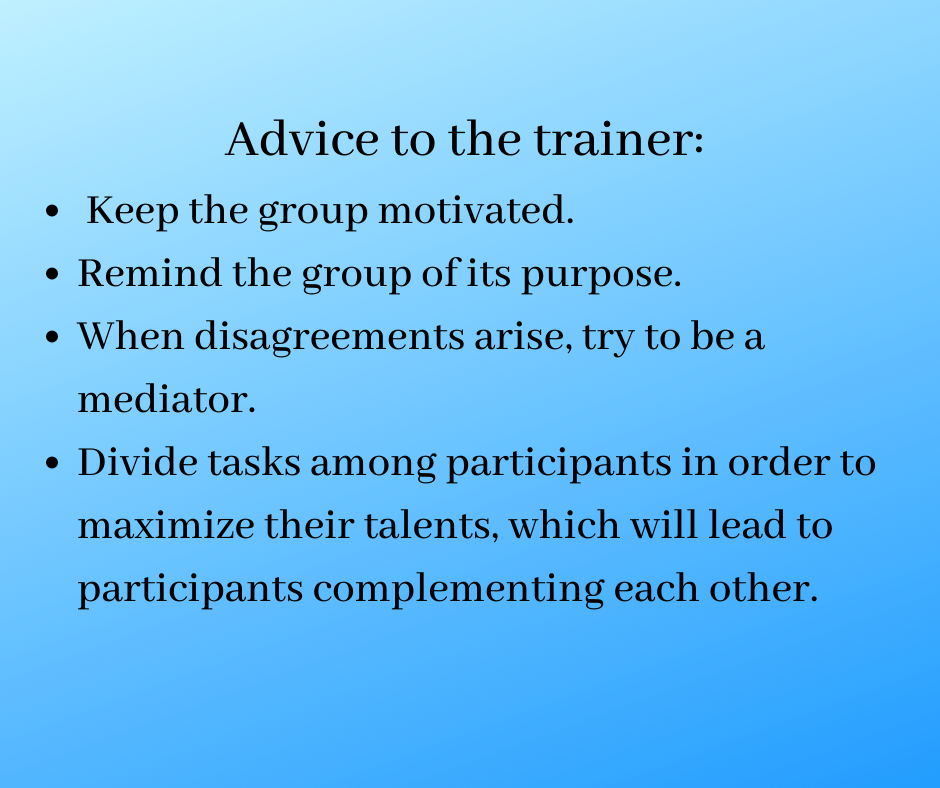In a group of people, through constant interactions, changes happen, processes and relations between participants and the trainer take place. The functioning of each group is divided into different phases. The trainer’s tasks vary in each phase of group functioning. Therefore, a good trainer must know each phase in detail and know what mechanisms are taking place between the participants. Awareness of the processes occurring in the group, which are natural, gives the trainer the opportunity to adjust his/her behavior to a given situation, in order to make the learning process the most effective as possible.
The most popular and widely quoted in the literature is the five-stage model of group development by B.W. Tuckman and M.A.C. Jensen. This model distinguishes the following stages of group formation:
STAGE 1 FORMING
This is the stage when the team members meet for the first time, the group participants get to know each other and the group evolves. Participants are very carefull, they are kind to each other, no one gets carried away, and they are holding back their emotions. Interactions between the team members are casual. This stage generates stress because no one knows anything. Participants don’t know exactly what will happen during the training or how the other co-participants will behave. Everyone is watching and waiting for events to unfold. Therefore the group focuses on the person of the trainer, relies on him and expects him to provide the group with a sense of security. At this stage, the priority is to build the commitment of the members and there is a shift from “I” to “we” thinking.

STAGE 2. STORMING
This phase is characterized by conflicts in all aspects of the group functioning. At this stage, the group gets to know each other not only from the “good side,” but also turns out to have faults. Not all participants get along, there may be people in the group who do not accept the goal set for the group. Group members show impatience, begin to doubt in the success of the group and do not hide their personal goals, a lack of desire to continue is often manifested. Participants criticize each other, question decisions, become silent, observant. Subgroups, coalitions and oppositions may also form. Repeated lateness can also be noticed. The crisis that occurs in this phase is necessary to “clear the atmosphere” and move on to the next stage. In order to continue further constructive group work, it is essential to allow each participant to talk about his or her feelings in a safe group atmosphere.

STAGE 3 NORMING
At this stage, the group has already dealt with the conflicts, the participants move to substantive discussions, open themselves to exchange views, show support for each other, share views, are ready to consider alternatives, relationships are strengthened and the so-called “spirit of cooperation” becomes apparent. Group members feel accepted and satisfied that they have managed to get through the crisis and difficulties. The “unwritten” rules of the group are established. The roles of individual participants in the group also emerge. At this stage, the group becomes more independent and stable. The role of the trainer becoming reduced to observing.

STAGE 4: PERFORMING
This is the phase of effective cooperation that promotes the achievement of the common goals. The group becomes a cohesive and effective team, utilizing the talents and skills of the individual members. Participants feel safe in the group, want to cooperate, have a sense of accomplishment, communicate openly with each other, and often put the group’s goals above their own. They are also open to constructive feedback. New and creative solutions are implemented. Participants starting talking about the further cooperation and want to maintain relationships and be supportive of each other.

STAGE 5: ADJOURNING
At this stage, the cooperation is terminated due to the achievement of the goals or because all the participants have already left the group. In this phase, formal relationships between participants disappear and informal relationships get weaker. Participants take on other challenges. They feel the bitterness of failure or the joy of shared achievements. In this phase, it is important to close the group when the cooperation ends. The purpose of this phase is to show the participants how the information gained during the group work, could be useful for them in the future.

In the SESKAT project, we recognized effective group management as one of the essential skills of a good trainer. Unfamiliarity with the group and its natural stages of development makes an educator’s job more difficult.
However, it is worth to remember that not every group goes through all the stages and that the boundaries between stages are fluid. In the group process, there are always emotions and interactions between people, crises arise and the group have to overcome difficulties in order to move into the next stages. In the group process, it is natural that conflicts and cooperation are intertwined, they are necessary and inevitable. Therefore, you as a trainer play a very important role in the educational process of the group. Your knowledge of how to deal with the conflicts and emotions of the participants is crucial in guiding the group through the next phases and bringing the cooperative learning process to a positive conclusion.